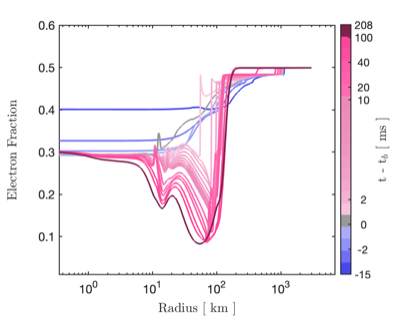
|
Cococubed.com
|
| FLASH-X |
Home
Astronomy research
Software Infrastructure:
MESA
FLASH-X
STARLIB
MESA-Web
starkiller-astro
My instruments
Neutrino Emission:
Neutrinos from de-excitation
Neutrino emission from stars
Identifying the Pre-SN
Neutrino HR diagram
Pre-SN Beta Processes
Pre-SN neutrinos
White dwarf pulsations:
12C(α,γ) & overshooting
Probe of 12C(α,γ)16O
Impact of 22Ne
Impact of ν cooling
Variable white dwarfs
MC reaction rates
Micronovae
Novae
White dwarf supernova:
Stable nickel production
Remnant metallicities
Colliding white dwarfs
Merging white dwarfs
Ignition conditions
Metallicity effects
Central density effects
Detonation density
Tracer particle burning
Subsonic burning fronts
Supersonic fronts
W7 profiles
Massive stars:
Pop III with HST/JWST
Rotating progenitors
3D evolution to collapse
MC reaction rates
Pre-SN variations
Massive star supernova:
Yields of radionuclides
26Al & 60Fe
44Ti, 60Co & 56Ni
SN 1987A light curve
Constraints on Ni/Fe
An r-process
Effects of 12C +12C
Neutron Stars and Black Holes:
Black Hole spectrum
Mass Gap with LVK
Compact object IMF
He burn neutron stars
Stars:
Hypatia catalog
SAGB stars
Nugrid Yields I
He shell convection
BBFH at 40 years
γ-rays within 100 Mpc
Iron Pseudocarbynes
Pre-Solar Grains:
C-rich presolar grains
SiC Type U/C grains
Grains from massive stars
Placing the Sun
SiC Presolar grains
Chemical Evolution:
Radionuclides in 2020s
Zone models H to Zn
Mixing ejecta
Thermodynamics, Opacities & Networks
Radiative Opacity
Skye EOS
Helm EOS
Five EOSs
Equations of State
12C(α,γ)16O Rate
Proton-rich NSE
Reaction networks
Bayesian reaction rates
Verification Problems:
Validating an astro code
Su-Olson
Cog8
Mader
RMTV
Sedov
Noh
Software Instruments
AAS Journals
2025 AAS YouTube
2025 Listing of 500+ Author Videos
2025 AAS Peer Review Workshops
2025 ASU Energy in Everyday Life
2025 MESA Classroom
Other Stuff:
Bicycle Adventures
Illustrations
Presentations
Contact: F.X.Timmes
my one page vitae,
full vitae,
research statement, and
teaching statement.
In this article Flash-X is a highly composable multiphysics software system that can be used to simulate physical phenomena in several scientific domains. It derives some of its solvers from FLASH, which was first released in 2000. Flash-X has a new framework that relies on abstractions and asynchronous communications for performance portability across a range of increasingly heterogeneous hardware platforms. Flash-X is meant primarily for solving Eulerian formulations of applications with compressible and/or incompressible reactive flows. It also has a built-in, versatile Lagrangian framework that can be used in many different ways, including implementing tracers, particle-in-cell simulations, and immersed boundary methods.
Flash-X is avaliable here, and documentation is here.

Implementation of inheritance. |

Ye profiles post bounce in core-collapse. |
FLASH: An Adaptive Mesh Hydrodynamics Code for Modeling Astrophysical Thermonuclear Flashes - 2000
In this article, we report on the completion of the first version of a new-generation simulation code, FLASH. The FLASH code solves the fully compressible, reactive hydrodynamic equations and allows for the use of adaptive mesh refinement. It also contains state-of-the-art modules for the equations of state and thermonuclear reaction networks. The FLASH code was developed to study the problems of nuclear flashes on the surfaces of neutron stars and white dwarfs, as well as in the interior of white dwarfs. We expect, however, that the FLASH code will be useful for solving a wide variety of other problems. This first version of the code has been subjected to a large variety of test cases and is currently being used for production simulations of X-ray bursts, Rayleigh-Taylor and Richtmyer-Meshkov instabilities, and thermonuclear flame fronts. The FLASH code is portable and already runs on a wide variety of massively parallel machines, including some of the largest machines now extant.
 |

|

|
|
The first bare-knuckles version of FLASH was created by Kevin Olson (he had PARAMESH and his hands on the keyboard), Bruce Fryxell (he had the hydro), and me (had the local physics) in late 1998 in the Laboratory for Astrophysics and Space Research (LASR) building where Kevin and I shared an office. We had some nifty SGI O2 desktop computers at the time. Shortly thereafter Paul Ricker (had the gravity) and Mike Zingale (had the viz and all-purpose skills) added critical capabilities. Jonathan Dursi and Alan Calder made key contributions and gave the development team a critical mass.